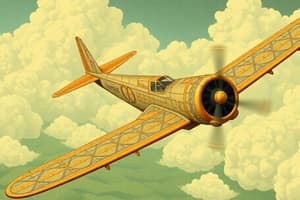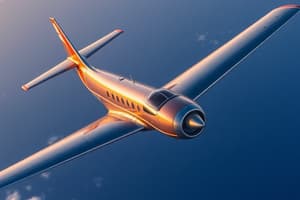Podcast
Questions and Answers
What is the main reason planes are designed to minimize drag?
What is the main reason planes are designed to minimize drag?
- To decrease thrust
- To enable forward motion with ease (correct)
- To reduce weight
- To increase lift
What scientific theory explains how a plane is able to fly?
What scientific theory explains how a plane is able to fly?
- Einstein's Theory of Relativity
- Newton's Third Law of Motion (correct)
- Newton's Second Law of Motion
- Newton's First Law of Motion
What is the approximate weight of one cubic meter of air at sea level?
What is the approximate weight of one cubic meter of air at sea level?
- 0.5 kg
- 1.25 kg (correct)
- 2.5 kg
- 5.0 kg
What organization has seven math problems on their website, one of which deals with air flow?
What organization has seven math problems on their website, one of which deals with air flow?
What are the four forces that must work together for a plane to fly?
What are the four forces that must work together for a plane to fly?
What is the primary function of a plane's wing?
What is the primary function of a plane's wing?
What is the approximate weight of the A-380 plane?
What is the approximate weight of the A-380 plane?
What is the term for the upward force that allows a plane to fly?
What is the term for the upward force that allows a plane to fly?
How does the wing of a large passenger jet, like the A-380, achieve lift?
How does the wing of a large passenger jet, like the A-380, achieve lift?
What is the purpose of thrust in a plane?
What is the purpose of thrust in a plane?
What is the effect of drag on a plane?
What is the effect of drag on a plane?
What is the approximate weight of the Cessna 172 plane?
What is the approximate weight of the Cessna 172 plane?
What is the required angle of the wing on a large passenger jet, like the A-380?
What is the required angle of the wing on a large passenger jet, like the A-380?
Flashcards are hidden until you start studying
Study Notes
How Planes Fly
- A plane's wing is an 'air deflector', pushing air down, which in return pushes the wing up, generating 'lift' that allows the plane to stay in the air.
Lift
- Lift is one of the four essential elements for a plane to fly, along with weight, thrust, and drag.
- The A-380 plane, weighing nearly 600 tonnes, can stay 12,000m above the Earth by constantly pushing air down.
Wing Angle
- The wings of large passenger jets are attached to the plane's body at an angle of about 5-10 degrees, tilting upwards at the front, which causes the plane to rise up.
Balance in Flight
- The plane stays balanced in-flight because of how the weight is distributed, avoiding being nose-heavy or tail-heavy.
Thrust
- Thrust is the force that moves the plane forward, produced by propellers or jet engines.
Drag
- Drag slows the plane down, similar to walking against a strong wind.
- Planes are designed to minimize drag, allowing them to travel forward with ease.
Newton's Third Law of Motion
- A plane's ability to fly can be explained through Newton's Third Law of Motion, which states that 'for every action, there is an equal, but opposite, reaction'.
Interesting Facts
- Air has weight, with one cubic metre of air weighing about 1.25kg at sea level.
- The Clay Mathematics Institute has a problem related to air flow, and solving it can earn over $1 million.
Studying That Suits You
Use AI to generate personalized quizzes and flashcards to suit your learning preferences.




